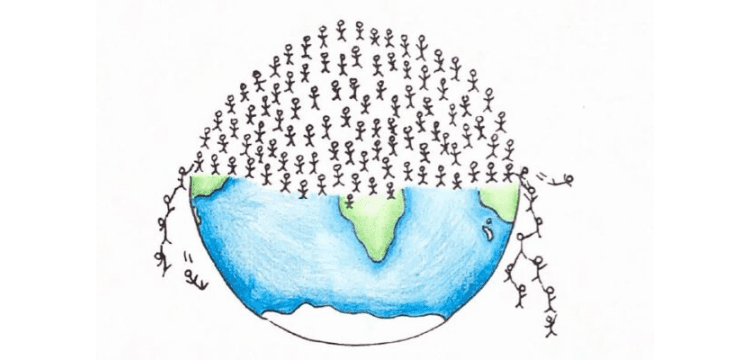[vc_row][vc_column][vc_column_text dp_text_size=”size-4″]United Nations Population Fund (UNPF) ranked Pakistan as the fifth-largest country in the world in 2022, with an estimated population of 229.5 million. Pakistan’s population growth rate stood at 2.40% for the last five years, according to the report published by the Pakistan Bureau of Statistics. This accelerated growth rate resulted in the addition of a staggering 22 million individuals within a mere five-year timeframe. The report also noted that 38.3% of the population faced multidimensional poverty.
The uncontrolled population growth increases the risk of food insecurity, provision of health and education, urban sprawl, traffic congestion, and also degradation of the environment. Health challenges, including high malnutrition rates, infectious diseases, and maternal and infant mortality, are further exacerbated by population growth. A contagious disease outbreak, such as the COVID-19 pandemic, tends to severely impact Pakistan’s healthcare system and the ability to fight other threats to human security, underscoring the link between national security and health.
Also Read: Population decline in China first time since 1961 Emphasizes the demographic issue.
Furthermore, population growth negatively impacts social welfare and economic stability. Large populations can strain resources and pose governance challenges, increasing the risk of civil unrest. A youth demographic with high unemployment rates can also lead to social instability and radicalisation.
This youth bulge is a challenge for Pakistan but can be transformed into an opportunity. A larger, well-trained population can enhance economic growth and contribute to the development of indigenous agriculture and industry. The youth can also be an asset if they are able to be trained and develop skill sets according to international standards to provide the workforce for the global economies facing aging issues and needing qualified, young human resources.
On the other hand, Pakistan’s population puts immense pressure on natural resources such as water, energy, and food. A concerted effort focused on population management is crucial for effectively managing natural resources. Historically, population management has faced challenges due to a lack of political ownership, ineffective national awareness campaigns, and social taboos. It is imperative to prioritize population control as a critical solution to address the issue of stress on Pakistan’s natural resources.
UNFP showed Turkey’s population in 2019 was estimated at 83 million, rising from 28 million in 1960 and 87 million in 2022. The annual population growth rate was 2.85 percent in the early 1960s, which declined to 1.83 percent in 1990-2000. Turkey has controlled this growth rate by introducing the five-year development program (1963-67). Likewise, Bangladesh’s population was overgrowing over the years. Currently standing at around 165 million with an annual growth rate of 1 percent, the country’s population is estimated to increase by 1.6 million yearly. The government introduced policies to control the growth rate, resulting in a decline of 1.72 percent in 2005 and 1.2 percent in 2010, with a population size of 147.6 million.
Pakistan should prioritize efforts to curb the unrestrained growth of its population. The population growth must be controlled, and on the other hand, the population’s potential must be harnessed positively. A comprehensive approach is needed to tackle the issue. Following the footsteps of the neighbouring Islamic states, the government should prioritize improvements in the healthcare sector. These include promoting awareness about the benefits of smaller families and their positive impact on the environment and providing affordable and quality reproductive health services such as family planning and contraception.
In addition, the government can incentivise smaller families by offering tax breaks, financial support, and other benefits to motivate people to have fewer children. Another critical initiative is promoting health education, particularly for women and girls, which can reduce fertility rates. Access to education and encouragement of higher education for women can empower them to make informed family planning decisions, contributing to population control.
Furthermore, it is required to promote sustainable practices among the existing population, such as adopting energy-efficient technologies, sustainable agriculture, and waste management. The current population should be viewed as a resource for the country, and efforts should be made to utilize it to boost the economy. When the population is equipped with skills and training that enable them to contribute valuable resources, it becomes feasible for them to address the challenges faced by countries grappling with the issue of an aging population. By implementing these measures, Pakistan can build a more sustainable society, alleviate the strain on its resources, and achieve balanced development while stabilizing its economic condition.
Ujala Siddiq is a researcher at the Centre for Aerospace and Security Studies (CASS), Lahore, Pakistan. She may be reached at [email protected].
[/vc_column_text][/vc_column][/vc_row]











